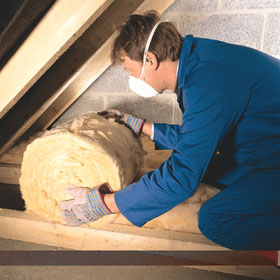insulation

Insulation is a material that prevents or slows down the movement of heat. Lining your "thermal envelope" – adding materials that don't readily allow heat to leak through your walls, ceilings, floors, from around your home's foundations and its ductwork – saves energy by keeping heat in during the winter and keeping heat out during the summer.
The effectiveness of a piece of insulation is measured by its R-value. The R-value in insulation designates its resistance to heat flow. The higher the R-value, the greater the insulating ability – the more effective it is. Generally speaking, each time you double the R-value of insulation, you cut your conduction heat loss in that area in half.
Adding insulation to an uninsulated attic is the most cost-effective, energy-saving measure you can do. Most older houses were built with little or no insulation. In more moderate climates, the minimum recommended R-value is R-30 for an attic, R-11 for walls, R-19 for raised floors, and R-4.2 for ductwork.
Installation tips
You can greatly increase the energy efficiency and comfort of a home by installing insulation with an R-value higher than the minimum requirements. But to truly enjoy the benefits of insulation, it must be installed correctly. Compressing it or leaving gaps through which air can flow can cut insulation's effectiveness in half.
When insulating your attic, it's important not to clog the attic vents under the eaves. Keep air circulating freely above the insulation by installing baffles (typically a piece of fiberglass batt placed several inches away from the vent).
For fire safety, keep insulation clear of heat producing devices such as doorbell transformers and recessed lights, flues or vents from furnaces, water heaters, fireplaces, and exhaust fans.
Types of insulation
Insulation comes in six basic varieties:
Fiberglass insulation available as blanket-like batts is the industry standard. It's actually glass, spun into long fibers, then woven and coated with a binding agent. Now available with 30 percent or more post-consumer recycled glass, fiberglass also comes as loose-fill and as rigid boards. Fiberglass batt insulation is popular because it's relatively easy to install, and batts are manufactured to fit the standard spaces between studs. Fiberglass is resistant to both fire and mold and small amounts of moisture have little effect on its R-value. The characteristics of fiberglass that make it popular can also be drawbacks. Batts of insulation designed for normal-sized cavities do not readily fit into irregular spaces. That can result in uninsulated spaces if installation isn't done carefully. Air movement around the insulation can significantly reduce its R-value.
Mineral-fiber insulation includes slag wool, which is made from melted industrial or steel mill slag that is spun into fibers. The fibers, treated with oil and binders to suppress dust and maintain the material's shape, can be woven into batts. A second type of mineral-fiber insulation called rock wool is manufactured in a similar way using natural basalt rock instead of slag. Mineral-fiber insulation looks, feels and performs much like fiberglass. It, too, is sold as batts, loose-fill and rigid boards, and has the same benefits and drawbacks as fiberglass insulation. Since it doesn't melt or support combustion, it is a good material for insulating around chimneys.
Cellulose thermal insulation is made from finely shredded newsprint that is chemically treated to resist fire, corrosion, vermin and fungal growth. It contains at least 70 percent post-consumer paper waste. Only available in loose-fill form, it is either poured in place or installed with a blower. Because of the small size of the particles, cellulose can 'flow' around obstructions such as nails, electrical wires, trusses and braces to fill cavities uniformly. One drawback of insulating with cellulose is that it can settle over time if the insulation is not blown or poured to manufacturer's recommended density.
Vermiculite is a mineral closely related to mica. When heated, it expands to form a lightweight material with insulating properties. Two types of vermiculite are used as insulation: untreated and treated. Untreated vermiculite readily absorbs water and dries very slowly. The treated material is coated with asphalt to make it water-repellent for use in high moisture areas. Both types of vermiculite are usually installed by hand, a simple process. It is non-combustible, odorless and non-irritating. It doesn't offer as high an R-value as other types of insulation, however.
Rigid foam insulation is applied directly to framing as rigid sheets. Several types of foam are available, some with post consumer recycled content made from reclaimed fast-food containers and cups. Rigid foam is the insulation of choice where space is very limited but a high R-value is needed. It can be installed on the interior or exterior of a wall, but on the inside it must be covered by a fire-resistant material like wallboard. When the joints between panels are properly sealed, rigid foam insulation can act as both an air and vapor barrier.
"Expanded" types of rigid foam insulation are CFC-free; they are now manufactured with a non-chlorofluorocarbon (CFC) gas. "Extruded" types, which offer higher performance, originally were made with CFCs before manufacturers switched to using hydrochlorofluorocarbons (HCFCs), substances with far less potential to deplete the Earth's fragile ozone layer. While new extruded products that don't even contain HCFCs will soon become available, they contain chemicals that are still being evaluated to see what their effect will be on global warming. One drawback to most foam insulation is that it deteriorates unless it is protected from prolonged exposure to sunlight and water. It also tends to be more expensive than most other types of insulation.
Urethane foams are also high-performance insulating materials available as rigid boards as or sprayed-in-place systems. Once made with CFCs, they are now made with more environmentally benign HCFCs.
